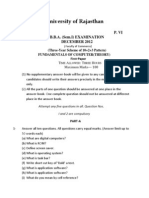0% found this document useful (0 votes)
14 views30 pagesLec6-Group Functions
This lecture covers the use of group functions in SQL, including how to identify and apply functions like AVG, COUNT, MAX, MIN, and SUM. It explains the syntax for using these functions with the GROUP BY and HAVING clauses to group and filter data. Additionally, it highlights the importance of handling null values and provides examples of illegal queries related to group functions.
Uploaded by
pakizaasif0031Copyright
© © All Rights Reserved
We take content rights seriously. If you suspect this is your content, claim it here.
Available Formats
Download as PDF, TXT or read online on Scribd
0% found this document useful (0 votes)
14 views30 pagesLec6-Group Functions
This lecture covers the use of group functions in SQL, including how to identify and apply functions like AVG, COUNT, MAX, MIN, and SUM. It explains the syntax for using these functions with the GROUP BY and HAVING clauses to group and filter data. Additionally, it highlights the importance of handling null values and provides examples of illegal queries related to group functions.
Uploaded by
pakizaasif0031Copyright
© © All Rights Reserved
We take content rights seriously. If you suspect this is your content, claim it here.
Available Formats
Download as PDF, TXT or read online on Scribd
/ 30




























































































